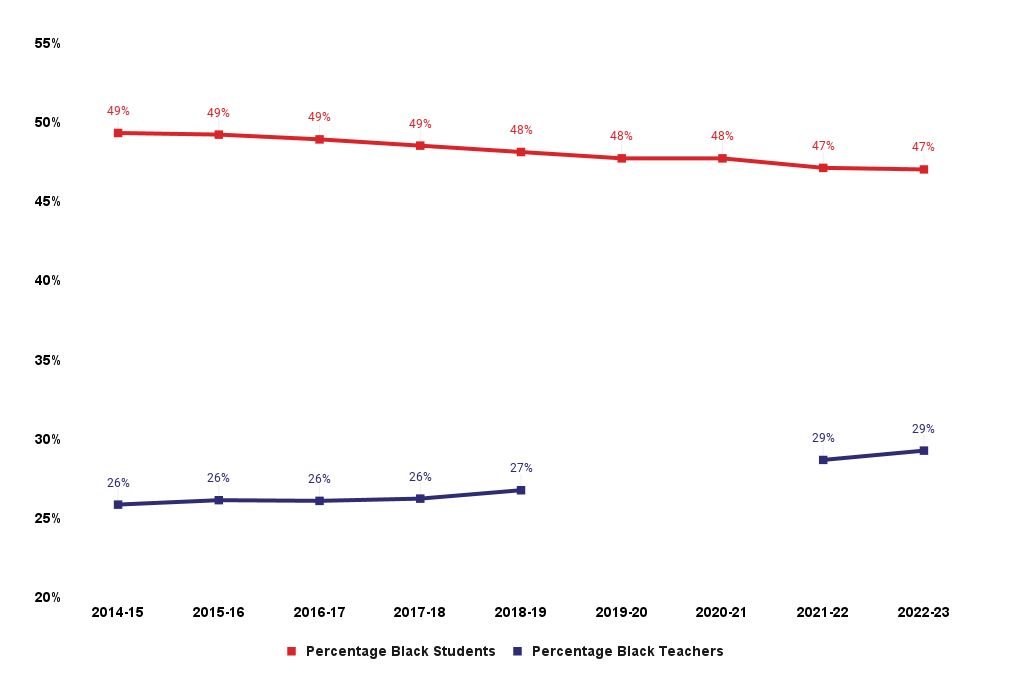Editor’s Note: This blog post is part of an ongoing series of posts dedicated to K-12 education policy in Mississippi.
***

By Grace Breazeale I K-12 Policy Associate
A growing body of research indicates that students of color benefit when their race or ethnicity is represented in the teacher workforce. Unfortunately, Mississippi’s teacher workforce does not reflect the diversity of its student population: nearly 70% of the state’s teachers are White, while only 43% of students are White. The table below details the demographic breakdown of teacher and student populations.
Mississippi Teacher and Student Demographics: 2022-2023 School Year
| Teachers | Students | |
| White | 69.42% | 42.59% |
| Black | 29.25% | 46.99% |
| Hispanic | 0.69% | 4.76% |
| Asian | 0.41% | 1.12% |
| Native American | 0.08% | 0.22% |
| Pacific Islander | 0.02% | 0.07% |
Though the Mississippi Department of Education (MDE) has recognized the need to diversify the teacher workforce—and gaps in representation are slowly improving—the profession has a long way to go. Along with continuing implementation of current initiatives, state and district leaders should consider exploring additional strategies to encourage the entry and retention of teachers of color.
Benefits of a Diverse Teacher Workforce
Across all types of professions, the value of a diverse workforce cannot be overstated. A workforce with a variety of perspectives, ideas, and backgrounds is inherently stronger, more creative, and more adaptable than a workforce that is homogenous. Diversity in the teacher workforce, specifically, takes on the additional importance of exposing young learners to adults from a variety of backgrounds and perspectives, showing them different ways of learning and thinking.
Research backs up this notion about the importance of diversity in the teacher workforce and has specifically shown that minority students benefit when their race or ethnicity is represented in the teacher workforce. For the purpose of this analysis, we will primarily focus specifically on the advantages that increasing the representation of Black teachers can have on Black students, as the vast majority of teacher diversity research has focused on this group, and Black students comprise the largest demographic group in Mississippi’s student population.
For Black students, studies indicate that having a Black teacher is associated with improved grades, standardized test scores, attendance rates, and graduation rates. Studies have also shown that Black teachers are more likely to identify Black students as gifted and increase Black students’ chances of enrolling in advanced math courses. In terms of non-academic impacts, exposure to Black teachers may decrease Black students’ likelihood of receiving exclusionary discipline, which can help disrupt the school-to-prison pipeline. Additionally, having a more diverse teacher workforce may lead to greater parent and family engagement among Black families.
What explains these benefits? Research shows that Black teachers may have higher expectations for Black students, a factor that is linked to higher academic achievement. Additionally, Black teachers may forge stronger connections and serve as role models for Black students. Black teachers may also exhibit less implicit bias towards Black students.
Though most research on teacher diversity focuses on what this could mean for students of color, all students stand to benefit from a more diverse teacher workforce. Research has found that having a teacher of color can boost White students’ test scores and reduce their absenteeism rates, in addition to improving their critical thinking skills and having a “prosocial” impact on their racial attitudes. Moreover, increasing entry of people of color into the teacher workforce would have the added benefit of improving the state’s widespread teacher shortages. Given the implications of a more diverse teacher workforce for all students—regardless of their race—prioritizing this initiative is essential.
Historical Roots of Black Underrepresentation in Teacher Workforce
The underrepresentation of Black educators in the nation’s teacher workforce—particularly in the deep South—can be traced back to the 1953 Brown vs. Board of Education decision. Prior to this case, historians estimate that Black teachers made up 35% to 50% of the teacher workforce in states with segregated school systems. As schools slowly desegregated over the following decades, schools that served Black students were more likely to close than their White counterparts. Despite subsequent court rulings that segregation was also to occur among school staff and administrators, Black teachers were often pushed out of their jobs. Many of these teachers were forced to take lower-skilled jobs or move to other areas to teach. Decades later, the region’s public education system has not recovered from this loss of Black teachers.
Current State of Teacher Diversity in Mississippi
To measure the extent to which Black teachers are underrepresented in the teacher workforce, we can compute the student-based diversity gap. This measures the difference between the share of Black students in the student population and the share of Black teachers in the teacher workforce.
As we noted in the introduction, 29% of teachers were Black and 47% of students were Black during the 2022-2023 school year, producing a diversity gap of 18 percentage points. Though this gap is not insignificant, data from the past decade indicates that it has steadily narrowed.

*Note that we do not have data on the composition of the teacher workforce for the 2019-2020 or 2020-2021 school years.
The diversity gap provides a general picture of teacher diversity within the state. It is less useful for comparing districts to each other because it does not capture proportional differences in representation. For instance, one district could have a teacher workforce that is 85% Black and a student population that is 95% Black. Another district could have a teacher workforce that is 1% Black and a student population that is 11% Black.1 Both of these districts would be assigned a diversity gap of 10 percentage points, despite their differing compositions.
As a more effective measure for comparison between districts, we can use the “student-teacher parity index.” The index is calculated by dividing the percentage of students by the percentage of teachers in the districts. If 20% of students in a district are Black and 5% of teachers in a district are Black, for example, the district would have an index of 4.
In the map below, we divided school districts into three groups: districts that are closest to parity between the proportions of Black teachers and students (<1.5), districts with moderate differences in representation (1.5 to 4), and districts with substantial differences (>4). The latter group includes the areas that should focus most on improving teacher diversity, as these are the districts where Black students are least likely to encounter Black teachers.
Interestingly, the school districts that are not geographical critical shortage areas (CSAs) are most likely to have high indices, indicating large differences in the proportions of Black teachers and Black students. Only 7.3% of non-CSAs have an index below 1.5, while 48.5% of CSAs have an index below 1.5, indicating that they are at (or close to) parity. In short, Black students in geographical critical shortage areas are more likely to be exposed to Black teachers than Black students in non-shortage areas.
Current Barriers to Diversity
The overall disparity in representation between Black students and teachers, as well as the wide variation between districts, indicate a need for swift action. Targeting this issue requires identifying the points on the teacher pipeline where we are losing Black educators. Are potential Black educators choosing not to enter educator preparation programs? Are the ones who do enter leaving the programs at disproportionate rates? Or are the ones who become teachers leaving the profession prematurely? The answer, it turns out, is complicated.
In 2020, Mississippi First released a report demonstrating how the proportion of Black students in educator preparation programs (EPPs) fell between the 2010-2011 and 2017-2018 school years, across both traditional-route and alternate-route programs. From this data, we predicted that the lack of Black students in EPP programs could contribute to a less-diverse teacher workforce in the future. Since publishing the report, newly released data has given us reason to believe this may be changing. In the 2019-2020 and 2020-2021 school years, we saw a sharp increase in the proportion of Black students who enrolled in alternative-route programs and a moderate increase in the proportion of Black students who enrolled in traditional-route programs. This increasing diversity in EPPs is a hopeful sign for the future, and we will continue to monitor these numbers closely.
The state of the pipeline is less promising for Black teachers who are currently in the classroom. In a report based on survey data from the 2021-2022 school year, we demonstrate how Black teachers are at a much higher risk of prematurely exiting the classroom than their White counterparts. We connect this phenomenon to the relatively high financial insecurity of Black teachers. Follow-up data from a survey administered during the 2022-2023 school year (report forthcoming) showed similar patterns in attrition risk and financial insecurity. In essence, the financial realities of teaching could be pushing Black educators out of the classroom.
Efforts to Improve Teacher Diversity
Over the past several years, the MDE has recognized the need to increase the recruitment and retention of educators of color, setting a goal to increase the proportion of teachers of color to 32% by 2025. It has established initiatives to address barriers to this goal, many of which are also intended to help tackle the state’s teacher shortage. These initiatives include the following:
Evaluating Teacher Diversity Efforts
The state has implemented multiple projects to increase teacher diversity in recent years, but can we find evidence of their effect? The most straightforward measure of their effectiveness would be changes in the composition of the teacher workforce: as we described in a prior section, the gap between Black teachers and Black students has narrowed, slowly but steadily, indicating that teacher diversity initiatives have had some success.
We expect this gap to continue to narrow in the future, given the sharp increase in the overall number of EPP enrollees who identify as nonwhite in recent years. Most of the increase has been driven by enrollment in alternative route EPPs; traditional route EPPs have remained overwhelmingly White. Regardless, the overall increase in enrollment among Black students is a move in the right direction.
To further evaluate the state’s approach to improving teacher diversity, we can turn to EdTrust’s Teacher Diversity and Equity Report Card, which assesses the state across five different measures:
- Making educator diversity data visible and actionable
- Setting clear goals at the state and district level to increase access to diverse teachers
- Investing in educator preparation programs to increase enrollment and improve the preparation of teachers of color
- Targeting resources to districts and schools to support the hiring of a diverse workforce
- Investing in efforts to retain teachers of color
Mississippi only meets the full criteria for the second of these measures: setting goals to increase access to diverse educators. Though the importance of a diverse workforce is on the state’s radar and the state has taken concrete steps to promote this goal, the teacher workforce is still far from where it needs to be.
Strategies for Improvement
Below, we offer additional strategies that could help the state accelerate its progress in this area, while also strengthening the profession in general.
Conclusion
Increasing teacher diversity has clear benefits for all students across the state, which the state has begun to recognize and address. Progress has been slow but steady, and we commend the state’s efforts so far to accomplish this goal. Going forward, incorporating additional strategies could speed up the process and target it towards districts with the widest diversity gaps, allowing students in more areas to reap the advantages of a diverse teacher workforce.
1 Example adapted from a Brookings article on measures of teacher diversity.

